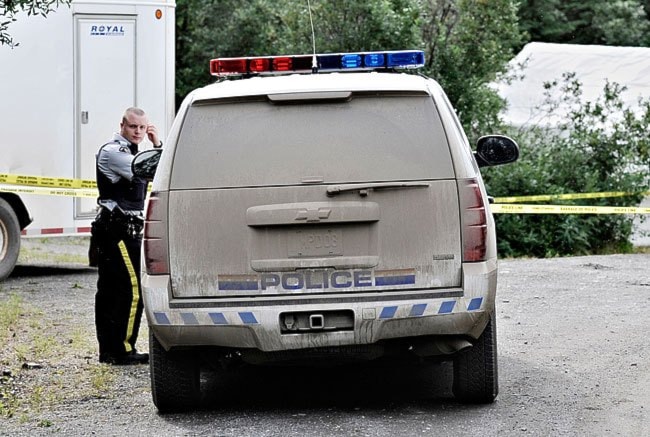A Whitehorse woman wants to put the RCMP on camera.
Jennifer Allen is trying to start Cop Watch Whitehorse, a group that would see volunteers at the ready to respond - cellphone cameras in hand - to calls of police misconduct and violence.
Allen’s already started one Cop Watch group in Vancouver’s Downtown East Side, a place known for frequent violent confrontations and systemic drug problems.
“I’ve had family and friends come down from Whitehorse and trained them in how to do outreach, how to talk with the community, what role plays in protests, to protect the protesters from police violence,” Allen said.
In Vancouver, cop watching was first started in the ‘90s by the Pivot Legal Society, a group that advocates for the homeless and disenfranchised in Vancouver. The movement also had a brief life with the anarchist Black Block crowd, but that too fell by the wayside.
Allen said she was at a community activists meeting about a year ago when the idea to revive the Vancouver Cop Watch came up. She and two other volunteers set up a new group called the Vancouver DTES Cop Watch, and a Twitter account to broadcast the actions of police in the area around Main and Hastings.
She said once the group started, word quickly spread and people would call her when they saw cops abusing their power.
“I’d get a call and go running out of the house to film what the police were doing,” she said.
In a couple of cases, catching violent cops on camera has been the perfect way to make them answer to the public, she said.
In late March, a video of three Vancouver Police Department officers punching a cyclist in the face landed stories about police violence on the front page of newspapers, and the video led the local TV news broadcast that night.
In another case a few years ago, a video showed a VPD officer shoving an elderly woman to the ground.
Neither case involved Cop Watch Vancouver directly, but Allen said they are good examples of what her volunteers can do.
She said after talking with family and friends in Whitehorse, she decided the Yukon capital needed her as well.
“It’s not right for me to be helping the people of Vancouver when the people of Whitehorse are suffering and being beaten up brutally and dying at the hands of the RCMP,” she said.
There have certainly been some troubling cases of police misconduct in the territory. The most notorious is the death of Raymond Silverfox, who died after 13 hours in police custody. During his ordeal, Silverfox was violently ill, vomiting 26 times and pleading for help. The officers outside his cell only mocked and ridiculed him, and he eventually died after inhaling his own vomit.
But Whitehorse is not Vancouver. Will an adversarial, cameras-in-cops-faces approach be helpful here?
Charlotte Hrenchuk, who co-ordinates the Yukon’s Status of Women Council, doesn’t think so. She sat in on a presentation Allen made about her group and why she says Cop Watch is important.
“When someone says their slogan is ‘name, shame and blame,’ that doesn’t really foster a good working relationship,” Hrenchuk said.
Hrenchuk worked with a number of women’s and community groups on Sharing Common Ground, a 2011 report into the RCMP’s weaknesses triggered in part by Silverfox’s death.
She said that document and a good body of other work shows that the RCMP are making significant strides towards improving their relationship with Yukoners.
“It’s not the same antagonistic or misunderstood kind of relationship that it was. There’s a lot more communication. We’re working together with the RCMP on a number of fronts,” Hrenchuk said.
“Things aren’t perfect, of course, and there are still things that go wrong and things that happen on the street that shouldn’t, and we are quick to point that out,” she said.
Hrenchuk pointed to one new protocol in particular, Together for Justice, which the RCMP developed alongside the Liard Aboriginal Women’s Society in Watson Lake as a way to address serious and long-standing conflicts with the RCMP in that town.
She said a group of Whitehorse organizations are working on a similar protocol for the capital, and she’s encouraged by the results.
“We think that things have improved greatly. What I would much prefer to see is something like a predator watch,” she said, adding that in her eyes, the biggest threats to vulnerable women in Whitehorse aren’t the police, but transient men who cruise the Salvation Army shelter preying on women.
“Those are the guys that I’m interested in targeting. We have a good working relationship, and we’re hoping that it will continue to improve at every level with the RCMP,” she said.
Const. Christine Grant, the Whitehorse detachment’s communications officer, agrees.
While there’s nothing the RCMP can do to stop someone from filming an arrest in a public place, she’s worried that sends the wrong message.
“We live in a world of social media now. Anyone at any time can videotape something with their cellphone. But it kind of has an adversarial way about it, and we’ve worked very hard to build positive relationships in the community. It does have sort of a negative view of things, and that’s unfortunate,” Grant said.
The Yukon already has a civilian watchdog, the Alberta Serious Incident Response Team, which reviews RCMP actions in the territory.
Contact Jesse Winter at
jessew@yukon-news.com
